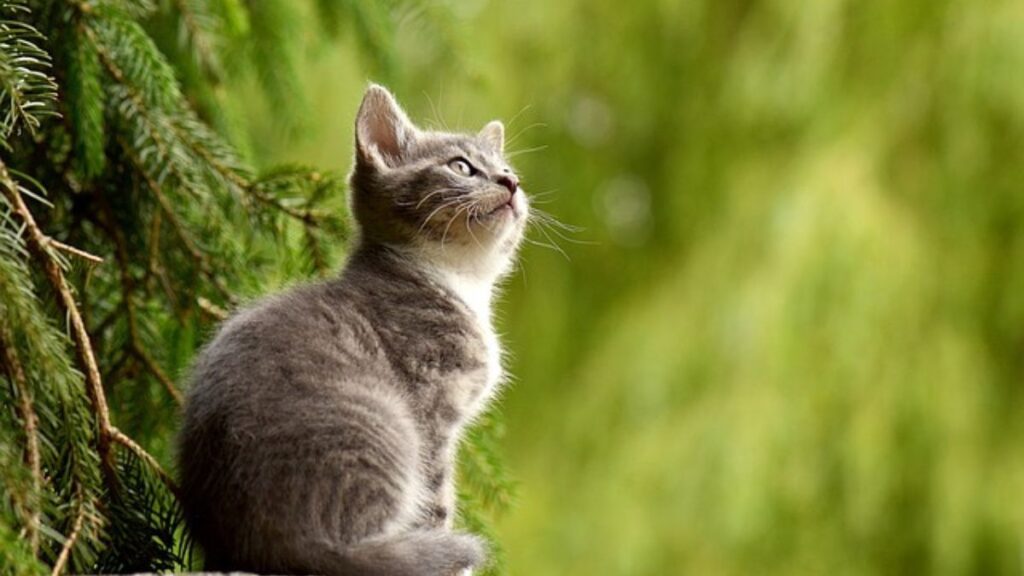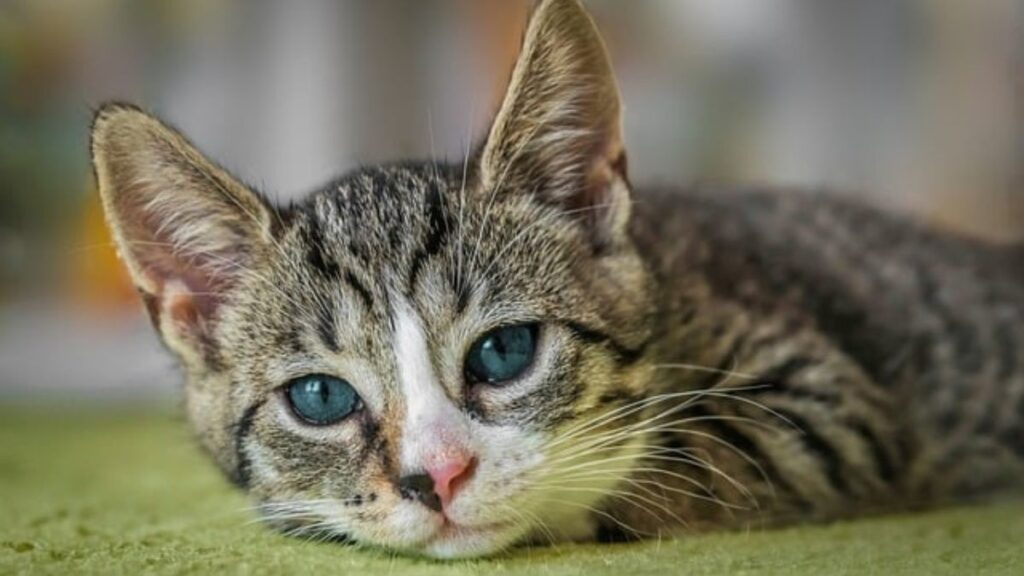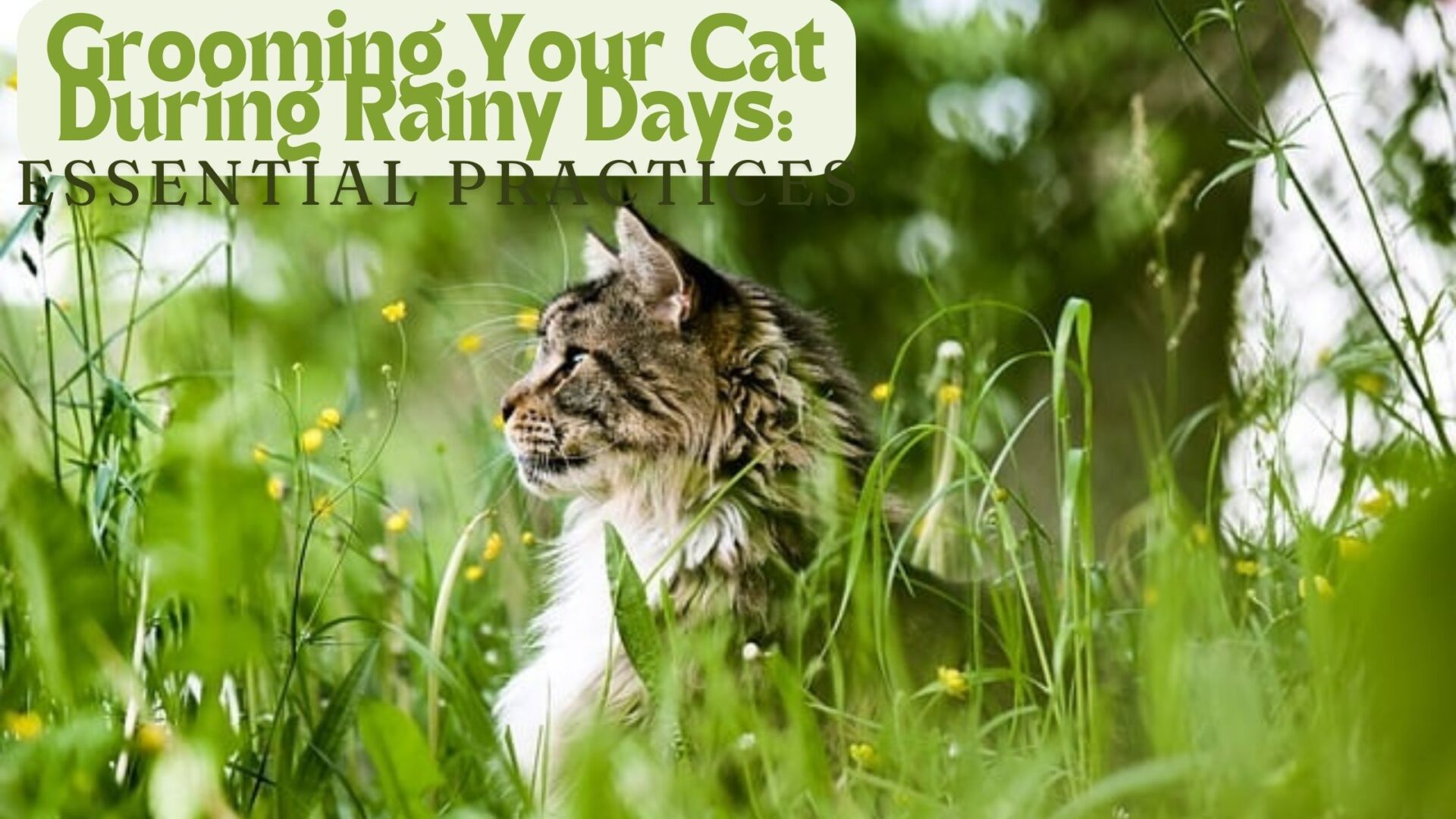Introduction:-
Grooming Your Cat During Rainy Days: Essential Practices

To ensure your feline companion’s well-being and comfort during rainy weather, meticulous grooming practices are essential. The heightened humidity and moisture can induce skin and coat problems if not adequately managed. Here’s a comprehensive guide to the optimal grooming routines for cats tailored specifically for rainy days:
Grooming Your Cat During Rainy Days
1. Regular Brushing:
- Why: Essential for removing loose fur, dirt, and debris that can lead to matting and discomfort.
- How: Use an appropriate brush or comb suitable for your cat’s fur type. Brush gently in the direction of hair growth to avoid discomfort.
2. Drying Wet Fur:
- Why: Prevents skin infections and keeps your cat warm.
- How: Gently towel-dry your cat if it gets wet. Use a hairdryer only if your cat is comfortable with it, and set it to the lowest heat setting.
3. Paw Care:
- Why: Wet paws attract dirt and bacteria that can cause infections.
- How: Wipe your cat’s paws with a damp cloth when it comes inside to remove dirt and grime. Check for any cuts or signs of infection.
4. Ear Cleaning:
- Why: Moisture buildup in the ears can lead to infections.
- How: Use a vet-approved ear cleaning solution and a cotton ball to gently clean your cat’s ears. Avoid using cotton swabs as they can damage the ear canal.
5. Litter Box Hygiene:
- Why: Dampness can cause litter to clump and harbor bacteria.
- How: Keep the litter box clean and dry by scooping it regularly. Change the litter as needed to maintain its freshness.
6. Bathing:
- Why: Occasionally necessary if your cat gets particularly dirty or muddy during extended rainy periods.
- How: Use a cat-specific shampoo and lukewarm water. Be gentle and rinse thoroughly to remove all shampoo residue. Dry your cat completely afterward.
By following these grooming practices, you can help keep your cat healthy and comfortable during rainy days, ensuring that your feline companion enjoys the rainy season just as much as you do.
7. Nail Care
Why: Wet conditions can soften your cat’s nails, making them prone to damage and breakage.
How: Regularly trim your cat’s nails to prevent them from splitting or breaking. Use a cat-specific nail trimmer and avoid cutting too close to the quick.
8. Skin and Coat Inspection
Why: Regular checks can help you identify early signs of skin problems or parasites.
How: Examine your cat’s skin and coat for any signs of redness, bumps, fleas, or ticks. Consult your veterinarian if you notice anything unusual.
9. Hydration and Diet
Why: Adequate nutrition and hydration contribute to your cat’s overall health and skin condition.
How: Ensure your cat has access to fresh water and a balanced diet. Consider incorporating supplements like omega-3 fatty acids to enhance coat health.
10. Comfort and Warmth
Why: Keeping your cat warm and comfortable is crucial to maintain their health during wet weather.
How: Provide your cat with a dry and warm resting area. Consider using heated beds or blankets if necessary.
By following these grooming practices, you can ensure that your cat remains clean, healthy, and comfortable during rainy days.
What vaccinations are crucial for my cat to have before the rainy season starts?
Vaccinations are essential to protect your cat from various infectious diseases, especially during the rainy season when the risk of infections can be higher. Here are the crucial vaccinations your cat should have before the rainy season starts:

1. Core Vaccinations
These are essential for all cats regardless of their lifestyle.
- Feline Viral Rhinotracheitis, Calicivirus, and Panleukopenia (FVRCP)
- Why: Protects against three highly contagious and potentially deadly diseases.
- Feline Viral Rhinotracheitis (FVR): A herpesvirus that causes severe upper respiratory infections.
- Feline Calicivirus (FCV): Causes respiratory infections, oral ulcers, and can lead to more severe disease.
- Feline Panleukopenia (FPV): Also known as feline distemper, a highly contagious and often fatal viral disease.
- Schedule: Initial series of shots at 6-8 weeks, followed by boosters every 3-4 weeks until 16-20 weeks of age, then a booster at one year, and subsequently every 1-3 years.
- Why: Protects against three highly contagious and potentially deadly diseases.
- Rabies
- Why: Rabies is a fatal viral disease that affects the nervous system and is transmissible to humans.
- Schedule: First vaccine at 12-16 weeks of age, followed by a booster at one year, and then every 1-3 years depending on local regulations and the vaccine used.
2. Non-Core Vaccinations
These are recommended based on your cat’s lifestyle and risk factors.
- Feline Leukemia Virus (FeLV)
- Why: FeLV is a contagious virus that can cause severe immunosuppression, anemia, and lymphoma.
- Schedule: Initial vaccine series at 8-12 weeks, followed by a booster 3-4 weeks later, then annually for cats at risk of exposure (those that go outdoors or live with FeLV-positive cats).
- Bordetella Bronchiseptica
- Why: Causes respiratory infections, particularly in multi-cat households or catteries.
- Schedule: Initial vaccination and then as needed based on risk of exposure (often required for boarding facilities).
- Chlamydophila Felis
- Why: Causes conjunctivitis and respiratory issues.
- Schedule: Initial vaccine series and then annually if the cat is at high risk.
- Feline Immunodeficiency Virus (FIV)
- Why: FIV affects the immune system, similar to HIV in humans.
- Schedule: Initial vaccine series and then annual boosters, primarily for outdoor cats or those at high risk of exposure.
3. Prevention Tips Before the Rainy Season
- Vet Check-Up: Ensure your cat is up to date on all vaccinations and discuss any additional vaccines that might be necessary based on your cat’s health and lifestyle.
- Parasite Prevention: Use flea, tick, and worm preventatives as recommended by your vet.
- Healthy Environment: Maintain a clean and dry living area to reduce the risk of infections.
By keeping your cat’s vaccinations up to date and following preventive measures, you can help ensure their health and well-being during the rainy season.
What dietary changes, if any, should I consider for my cat during the rainy season?
During the rainy season, certain dietary adjustments can help keep your cat healthy and comfortable. Here are some considerations and tips:

1. Hydration
- Why: Proper hydration supports overall health, including kidney function and digestion.
- How: Ensure your cat always has access to fresh, clean water. Consider adding wet food to their diet to increase water intake.
2. High-Quality Protein
- Why: Protein supports muscle maintenance, energy levels, and immune function.
- How: Provide a diet rich in high-quality animal protein. Check labels to ensure meat is the primary ingredient.
- Why: Omega-3 fatty acids support skin and coat health, which can be especially beneficial in damp conditions.
- How: Consider adding fish oil supplements or feeding your cat foods rich in omega-3s, such as salmon or fish-based cat food.
4. Digestive Health
- Why: Changes in weather can sometimes affect digestion.
- How: Include probiotics or foods with natural probiotics, like plain yogurt (in small amounts), to support gut health. Ensure any changes in diet are gradual to avoid digestive upset.
5. Weight Management
- Why: Cats may be less active during the rainy season, leading to potential weight gain.
- How: Monitor your cat’s weight and adjust portion sizes if necessary. Ensure the diet remains balanced and nutritious.
6. Immune Support
- Why: Wet and humid conditions can increase the risk of infections.
- How: Provide foods that support immune health, such as those containing antioxidants (vitamins E and C) and high-quality proteins. Consider supplements if recommended by your vet.
7. Avoid Human Foods
- Why: Some human foods can be toxic to cats or cause digestive issues.
- How: Stick to cat-specific foods and treats. Avoid giving your cat foods like onions, garlic, chocolate, and grapes.
8. Monitor Food Storage
- Why: High humidity can affect the quality and safety of stored cat food.
- How: Store dry food in airtight containers to keep it fresh and prevent contamination. Check expiration dates regularly.
9. Comfort Foods
- Why: Cats can be sensitive to changes in their environment, and familiar foods can provide comfort.
- How: Maintain a consistent feeding schedule and offer favorite foods to keep your cat happy and stress-free.
10. Consult Your Vet
- Why: Dietary needs can vary based on individual health conditions and lifestyle.
- How: Talk to your vet before making significant changes to your cat’s diet. They can provide personalized recommendations based on your cat’s specific needs.
By considering these dietary adjustments, you can help ensure your cat remains healthy, comfortable, and happy during the rainy season.
Conclusion
By implementing these preventive measures, you can greatly minimize the risk of your cat becoming ill during the rainy season. With a bit of extra care and attention, you can ensure your furry companion remains healthy and content, regardless of the weather conditions.
References
- ASPCA: Safeguarding Your Pet from Summer Heat and Humidity
- PetMD: Fungal Infections in Cats
- American Veterinary Medical Association: Flea and Tick Control
- VCA Hospitals: Upper Respiratory Infection in Cats
- Cat Care Clinic: Recommendations for Maintaining Your Cat’s Health








